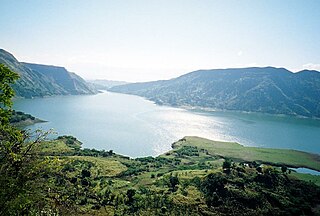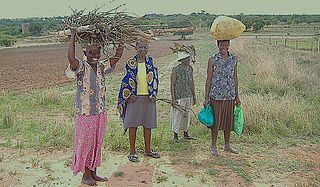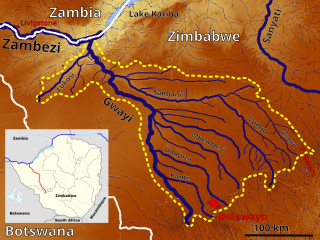
Masvingo, originally Victoria, is a province in southeastern Zimbabwe. It has a population of 1.485 million as of the 2012 census, ranking fifth out of Zimbabwe's ten provinces. Established by the British South Africa Company, it was one of the five original provinces of Southern Rhodesia. In 1982, two years after Zimbabwean independence, it was renamed Masvingo Province. The province is divided into seven districts, including Masvingo District, which contains the provincial capital Masvingo City.

Masvingo, originally known as Fort Victoria, is a city in south-eastern Zimbabwe and the capital of Masvingo Province. The city is situated close to Great Zimbabwe, the national monument from which the country takes its name and close to Lake Mutirikwi, its recreational park, the Kyle dam and the Kyle National Reserve where there are many different animal species. It is mostly populated by the Karanga people who form the biggest branch of the various Shona tribes in Zimbabwe.

The Honde Valley extends from the eastern border of Zimbabwe into Mozambique. The valley is part of the Eastern Highlands. The valley is about 130 kilometres from Mutare, or 110 kilometres from Nyanga. The Nyanga Mountains and the Nyanga National Park forms the western boundary of the valley.
Zhombe, originally known as Jombe, is a rural communal area in Kwekwe District, Midlands Province, Zimbabwe. It is an area of mixed Shona and Northern Ndebele People. It lies along the Mnyathi border line between Midlands and Mashonaland Provinces. There are a few commercial farms within its borders and a handful of resettlement areas. Most of it is within the Zhombe Constituency. Its administrative centre is the Zhombe Joel Growth Point, and it is under the Zibagwe Rural District Council.

Jawai Bandh is a dam built across the Jawai river, a tributary of Luni river, in Rajasthan.
Rutenga, is an important village in the province of Masvingo Province in Zimbabwe. It is the de facto capital of Mwenezi (District).

The Péligre Dam is a gravity dam located off the Centre department on the Artibonite River of Haiti. At 72 m (236 ft) it is the tallest dam in Haiti. The dam was created as a flood-control and an energy-providing measure in the Artibonite River Valley during the 1950s, as part of the Artibonite Valley Agricultural Project. This dam impounds Lake Péligre.

Mwenezi, originally known as Nuanetsi, is a small district situated in southern Zimbabwe. It is bisected by the Mwenezi River and the A4 highway, the main thoroughfare that connects the town of Beitbridge, on the border with South Africa, to Masvingo.

The Mwenezi River, originally known as the Nuanetsi River, is a major tributary of the Limpopo River. The Mwenezi River starts up in south central Zimbabwe and flows south-east along what is known as the Mwenezi River Valley that bisects the district into two sectors. The river is found in both Zimbabwe and Mozambique. In Zimbabwe it has been known as the Nuanetsi or Nuanetzi River in the past, a name it retains in Mozambique.

Maranda, locally known as "No. 1", is a small business center on the northern edge of Mwenezi (District), Zimbabwe. It is the home town of Dr. Love, the former popular musician and Nikita Mangena, Zimbabwe People's Revolutionary Army military leader during the Second Chimurenga war. It is a center of trade in the district, with people coming to sell their cattle in week-long trade fairs. The centre has a clinic and government agriculture and water offices.The land is occupied by The Vapfumbi people who speak Chipfumbi of the Kalanga and Karanga family and also partly the VhaVenda people who speak Tshivenda language.

Magomana is a small village located in Mwenezi (District). A string of mountains separates it from the main wall of Manyuchi Dam, less than five miles away in the north. The village is found on a watershed within the Maranda communal lands south of the Mwenezi River but north of the Mushawe River.

The Mushawe River is a right-bank tributary of the Mwenezi River in Zimbabwe. It rises in the Nemande mountain area and flows through the Maranda area to join the Mwenezi River downstream of Manyuchi Dam, Mwenezi District.
Matibi is a former native reserve, now known as a communal land, in Southern Zimbabwe. It is found in the northern section of Mwenezi (District), north east of Manyuchi Dam and the mighty Mwenezi River; bordered by Belingwe communals lands to the north and Maranda communal lands to the south. It is home to Neshuro, Sarahura business centers and the famous school Chegato.
Lower Gwelo is a developed communal settlement in the Midlands province, Zimbabwe and is located about 40km north-west of Gweru, and stretches a further 50 km to the west. Lower gwelo was initially called Somabhula and later became Somabhula ekhanyayo after establishment of Seventh day adventist missions stations that covered the entire area. Chiefdoms in Lower Gwelo include Sogwala, Sikombingo, Mdubiwa and Bunina. The settlement type is mostly linear along roads, although it is dispersed in some remote areas. There are several business centres which include Mission, Mankunzane, Makepesi, Sikombingo, Dufuya, Mangwande, Sogwala, Maboleni and Insukamini, a former district administration centre which is also one of the few state townships in the country. Maboleni and Insukamini are the two growth points within lower Gwelo.
Chitomborwizi is a farming area in Mashonaland West in Zimbabwe formerly known as Chitomborwizi African Purchase Area. The farms are small to medium sizes. Areas like these were created for black farmers during the colonial era, similar areas are Musengezi near Chegutu, Mushagashe near Chatsworth, Zimbabwe, Wilshere in Chivhu, Matepatepa in Mt Darwin to mention just a few.

Columbina Rural Service Center is a populated place in Zhombe. It is 95 km northwest of Kwekwe and 67 km southwest of Kadoma.
Ngondoma Irrigation Scheme is located in Zhombe, Kwekwe District in Zimbabwe's Agro-Ecological Region Three. The average annual rainfall for the location is 550 mm. The scheme area is 44.4 4 hectares. Of the 179 farmers in the scheme, 134 are women. It comprises members from various villages, including villagers from Chief Njelele side, Gokwe District on the other side of Ngondoma River.

Ngondoma Dam is a dam on the Ngondoma River located 500 meters west of the Empress Mine Township in the Midlands Province of Zimbabwe. The dam is 67 kilometers northwest of the Kwekwe and 54 km southwest of Kadoma.
Exchange Irrigation Scheme is a 165 hectare irrigated arable land in Zhombe Communal Land but in Silobela Constituency in Kwekwe District of the Midlands Province of Zimbabwe. It is 37 km southwest of Zhombe Joel, 83 km northwest of Kwekwe and 25 km north of Crossroads DSC.

Gweru River is a river in Midlands Province of Zimbabwe.



















